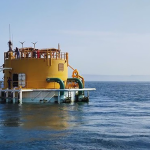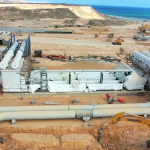Energy
Everything You Need To Know About The Government-Owned Ras Markaz Oil Storage Station

The crude storage terminal at Ras Markaz in the Wilayat of Duqm, Al Wusta Governorate, assumes significance as a vital project undertaken by Oman Tank Terminal Company (OTTCO) due to its strategic location in the vicinity of nascent markets in Asia and Africa.
The project seeks to manage and maintain an integrated network of tanks for different types of energy derivatives in the Sultanate of Oman, notably in Duqm.
Ard Van Hoof, CEO of OTTCO, said that the company has a clear-cut vision aimed to provide high-level storage services for liquid and gas products, including renewable energy products.
OTTCO boasts an infrastructure that is capable of meeting the requirements of the local and international markets.
The Ras Markaz Oil Storage Project is owned 100 per cent by the government, represented by OTTCO, said Eng. Salim Marhoon Al Hashmi, Director-General of the project, which, he said, began to be implemented in August 2019.
Al Hashmi pointed out that the Special Economic Zone at Duqm (SEZAD) granted OTTCO a 40-year usufruct rights to set up an oil storage facility at Ras Markaz with effect from the date of signing the said contract on July 5, 2017.
Al Hashmi told the Oman News Agency (ONA) that the Raz Markaz agreement provides for a storage capacity of 26.7 million barrels of oil in the first phase. The company will increase its capacity in tandem with the growth of demand from investors, said Al Hashmi.
The project consists of two streams: The first caters to the maritime business. It is completed and it comprises an import-export floating station situated 7kms from the beach, in addition to two 42-inch pipelines, Al Hashmi explained.
The second stream (over 80 per cent) features a variety of civil tasks, mountain demolishing, oil pumping systems, water treatment, installing tanks, building a power grid, and adding associated systems.
The infrastructure of the first phase of the oil storage project is ready to operate by the second quarter of 2022, said Al Hashmi.
He added that Ras Markaz station has been connected via an 80-km pipeline and that the facility constitutes a source of supplies for Duqm Refinery, where 8 mega tanks are dedicated for the purpose.
The project has a construction area of 10 square kilometres, while the total area stands at 40 square kilometres, which means the facility has a storage capacity of 200 million barrels of oil.
The floating terminal can receive very large crude carriers (VLCC) from around the world and it has been connected with four main stations to pump crude upwards, said Al Hashmi.
The Sultanate of Oman is currently leaning heavily on Mina Al Fahal for the export of crude oil, so the Ras Markaz station will add a strategic dimension to outbound crude export, said Al Hashmi, adding that the facility’s existence outside the Strait of Hormuz area will encourage many investors to store oil there and engage in import, export and oil blending operations.
Al Hashmi said that OTTCO envisages making Ras Markaz the largest oil storage facility of its kind the Middle East and a global hub in the Arabia Sea and Indian Ocean zones.
The project will generate 130 direct and indirect jobs, 90 of which will be occupied during the period of operation, said Al Hashmi, noting that more employment opportunities will be provided as the facility’s capacity keeps expanding.
Al Hashmi said that OQ Group and Aramco company of Saudi Arabia had signed a memorandum of understanding for the storage of their products at Ras Markaz, besides exploring other areas of cooperation related to the import, procurement, production, and storage of crude and petroleum products at Duqm Refinery and Ras Markaz.
-

 Real Estate2 months ago
Real Estate2 months agoAl Mouj Muscat Unveils Azura Beach Residences Phase 2: A New Chapter in Waterfront Living
-

 Leaders Speak1 month ago
Leaders Speak1 month agoDhofar International Development and Investment Company: Driving Sustainable Growth and Strategic Synergies in Oman’s Investment Landscape
-

 Events1 month ago
Events1 month agoOER Corporate Excellence Awards 2025 Honours Entities and Innovations in Oman
-

 Economy1 month ago
Economy1 month agoMaal Card: What Oman’s New National Payment Card Means for Everyday Users
-

 OER Magazines2 months ago
OER Magazines2 months agoOER, October 25
-

 Arts and Culture2 months ago
Arts and Culture2 months agoOminvest and Bait Al Zubair Launch “Future Frames” to Empower Youth through Art and AI
-

 Entertainment2 months ago
Entertainment2 months agoWhere Heritage Meets Haute Couture: Al Sadaa Haute Couture Transforms the Sultanate’s Fashion Scene
-

 News2 months ago
News2 months agoMs. Noor Saldin, Founder of Modern Generation International School, Wins Woman of the Year 2025; School Honored for Empowering Future Female Leaders

































